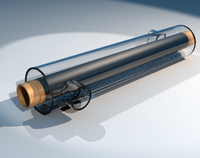
Photo from wikipedia
This paper presents a numerical study on the flow structures developed when a pulsed reaction control jet is operated in a hypersonic crossflow with a laminar boundary layer. Understanding these… Click to show full abstract
This paper presents a numerical study on the flow structures developed when a pulsed reaction control jet is operated in a hypersonic crossflow with a laminar boundary layer. Understanding these flow structures is important to the design of reaction control jets and scramjet fuel injectors. Implicit large-eddy simulations were performed with a round, sonic, perfect air jet issuing normal to a Mach 5 crossflow over a flat plate, at a jet-to-crossflow momentum ratio of 5.3 and a pressure ratio of 251, and with square-wave pulsing at Strouhal numbers of 1/6 to 1/3, based on jet diameter and free-stream velocity. Pulsing the jet allows the shock structure to partially collapse when the jet is off. This shock collapse affects the shedding frequency of shear-layer vortices, the formation of shear-layers downstream of the jet outlet, and the formation of longitudinal counter-rotating vortices. The lead shocks formed at jet start-up allow deeper penetration by increasing the effective jet-to-crossflow momentum ratio near the jet outlet and by preventing interaction between hairpin vortices. Normalised penetration was increased by a maximum of 68% compared with the steady jet. Pulsing also provides a higher jet interaction force per unit mass flow rate compared with a steady jet, with a 52% increase recorded at a 33% duty cycle. Temporal and spatial variations of surface pressure are important for reaction control applications and have been quantified. Pressure distribution depends strongly on duty cycle, and higher interaction force per unit mass flow rate was observed in cases with low duty cycle.This paper presents a numerical study on the flow structures developed when a pulsed reaction control jet is operated in a hypersonic crossflow with a laminar boundary layer. Understanding these flow structures is important to the design of reaction control jets and scramjet fuel injectors. Implicit large-eddy simulations were performed with a round, sonic, perfect air jet issuing normal to a Mach 5 crossflow over a flat plate, at a jet-to-crossflow momentum ratio of 5.3 and a pressure ratio of 251, and with square-wave pulsing at Strouhal numbers of 1/6 to 1/3, based on jet diameter and free-stream velocity. Pulsing the jet allows the shock structure to partially collapse when the jet is off. This shock collapse affects the shedding frequency of shear-layer vortices, the formation of shear-layers downstream of the jet outlet, and the formation of longitudinal counter-rotating vortices. The lead shocks formed at jet start-up allow deeper penetration by increasing the effective jet-to-crossflow momentum ra...
Journal Title: Physics of Fluids
Year Published: 2018
Link to full text (if available)
Share on Social Media: Sign Up to like & get
recommendations!